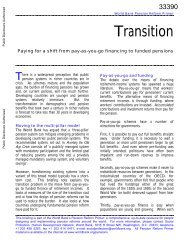Financial Sector Development in Africa: Opportunities ... - World Bank
Financial Sector Development in Africa: Opportunities ... - World Bank
Financial Sector Development in Africa: Opportunities ... - World Bank
Create successful ePaper yourself
Turn your PDF publications into a flip-book with our unique Google optimized e-Paper software.
42 Porteous<br />
Celpay and M-PESA: these two world-lead<strong>in</strong>g examples frame a<br />
decade of rapid development and accelerated deployment of mobile<br />
f<strong>in</strong>ancial services <strong>in</strong> <strong>Africa</strong>, 2 piggyback<strong>in</strong>g on the extraord<strong>in</strong>ary growth of<br />
mobile coverage and penetration on the cont<strong>in</strong>ent over this time. These<br />
two models also mark, respectively, the beg<strong>in</strong>n<strong>in</strong>g, and now the heyday,<br />
of what we characterize here as the second generation of mobile f<strong>in</strong>ancial<br />
services. This name dist<strong>in</strong>guishes these models from the first generation,<br />
which started earlier, and the third generation, which is only now<br />
start<strong>in</strong>g.<br />
Mobile telephony is no stranger to generational classification of its<br />
technology standards: so-called 1G (first generation) wireless networks,<br />
first launched <strong>in</strong> the 1980s, were the first commercially operat<strong>in</strong>g analogue<br />
wireless networks, but were soon overtaken <strong>in</strong> the 1990s by the<br />
rollout of “2G” networks, which had the advantage of digital switch<strong>in</strong>g.<br />
As demand for data communications soared, 2G networks that had <strong>in</strong>itially<br />
offered only basic data channels such as short message service<br />
(SMS) and unstructured supplementary service data (USSD) developed<br />
greater capability to handle data through implement<strong>in</strong>g 2.5G and 2.75G<br />
standards. Networks with these capabilities are pervasive throughout<br />
much of <strong>Africa</strong> today. However, the need for ever-faster transmission of<br />
data for Internet brows<strong>in</strong>g led to the deployment of commercial 3G networks<br />
from 2001 onward. First launched <strong>in</strong> places like Japan and the<br />
Republic of Korea, 3G is now widely available <strong>in</strong> cities and major urban<br />
areas <strong>in</strong> a number of <strong>Africa</strong>n countries. The lead<strong>in</strong>g edge of mobile technology<br />
has now moved on to 4G standards, with even faster stream<strong>in</strong>g<br />
speeds, although it has been deployed so far only <strong>in</strong> limited places such<br />
as Korea and certa<strong>in</strong> U.S. cities. 3<br />
The Generations of Mobile Payments<br />
The technological evolution described earlier provides the context for the<br />
evolution of mobile f<strong>in</strong>ancial services laid out <strong>in</strong> this chapter. While<br />
mobile f<strong>in</strong>ancial services have grown up <strong>in</strong> the wake of the spread of<br />
mobile phones and the growth of their capabilities, the generations we<br />
describe here are primarily based on the bus<strong>in</strong>ess models of the providers<br />
rather than on technology. Hence, to ma<strong>in</strong>ta<strong>in</strong> the dist<strong>in</strong>ction between<br />
technology and bus<strong>in</strong>ess model, we will use the conventional acronyms<br />
“2G” or “3G” where necessary only to refer to the technology standard,<br />
but we will specify “second generation” or “third generation” to refer to<br />
the evolution of mobile f<strong>in</strong>ancial services. This lens provides the best way







